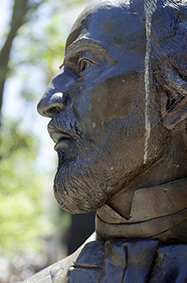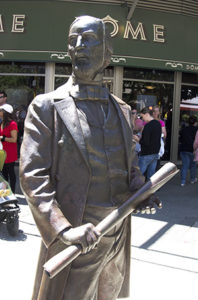John Septimus Roe statue

Public Art: John Septimus Roe statue
Sculptor: © Greg James
Description: The bronze statue of the Swan River Colony’s first Survey General, Sir John Septimus Roe (1797 -1878), stands on the site of what was once Roe’s family home. It is one of the few statues in Perth installed at street level (without a plinth or base).
Date: The John Septimus Roe statue was originally complete in 1990 but in 2007, the statue was donated to the City by MacCormac Architects and installed at its present location.
Location: John Septimus Roe can be found on the corner of Victoria Ave and Adelaide Terrace, Perth, Western Australia.

Inscription:
John Septimus Roe
1797-1878
First Surveyor-General of Western Australia
Roe arrived at the mouth of the Swan River with Lieutenant – Governor Captain James Stirling on 1 June 1829. He took up the post of Surveyor-General which he held until his retirement in 1870.
Roe is credited as being the State’s finest public servant, unmatched during forty years of service that included extensive surveying and mapping of territory, soil testing, exploration and ton planning. The sites of Perth and Fremantle were chosen on Roe’s recommendation and he was responsible for their initial design.
Roes’s scientific collection laid the foundations of what would become the Perth Museum and he, in company with other visionaries, was instrumental in having Kings park set aside as a public reserve.
So Who Was John Septimus Roe? :
John Septimus Roe was born at Newbury, Berkshire on the 8th May 1797.
A young Roe was a whiz at mathematics and was subsequently apprenticed to the Royal Navy at the age of 15. Roe’s first appointment was on the HMS Rippon in 1813 during the closing stages of the Napoleonic wars.
In 1817 the Admiralty appointed him to the surveying service in New South Wales, under the command of Captain Phillip Parker King.
His first role in Australia was to assist Captain Phillip Parker King on the 1817 -1822 expeditions of the Australian coast on the cutter Mermaid and later Bathurst. Onboard was also botanist Allan Cunnigham.
During the first journey, Roe nearly drowned in the Kalgan River while trying to circumnavigate Oyster Harbour. Following his misadventures, King named a point on the peninsula Mount Roe in Roe’s honour.
During the 1821 expedition on the Bathurst, Roe escaped serious injury when he fell 15m (50feet) from the masthead and was knocked unconscious.
On his return to Sydney, he again dodged death when his boat capsized while surveying Sydney harbour and 4 lives were lost.
Roe returned briefly to England before being assigned to help establish a settlement at Melville Island. From there he travelled to Ceylon, India and Rangoon carrying out naval duties and surveying.
Roe once again returned to England to recoup from a bout of bad health.
Having just missed out on the position of Surveyor-General of New South Wales, Roe instead excepted the position of Surveyor-General of Western Australia under the proviso he could leave the navy and take the role as a civilian appointment. They were happy to oblige.
Before setting sail on the Parmelia to establish the Swan River Colony in 1829, Roe proposed and married Matilda Bennett. They both boarded the ship together.
On arrival Roe quickly jumped to action, making preliminary surveys of the harbour, river and surrounding land. He chose Perth and Fremantle as key locations for towns. Much to his surprise and frustration, within 2 months of his arrival, three shiploads of settlers arrived, all expecting to take up land. As he and his assistant had been busy surveying the harbour and designing the layout of the town, they hadn’t had a chance to survey rural blocks. The pressure was on and so too an ever-increasing backlog. By April 1830, 36 ships full of settlers had arrived at the colony all expecting land. Roe and his assistant were under enormous stress and growing anger from disgruntled settlers.
In 1870 Roe retired due to his wife’s ill health and subsequent death. On his passing in 1878 John Septimus Roe was buried at East Perth Cemeteries.
Controversy: In October 1834 John Septimus Roe was a member of a party involved in the Pinjarra Massacre, one of the bloodiest and darkest days in Western Australia’s history. The party, led by Captain James Stirling, was seeking to “confront” (attack) the Binjareb Nyungars in retaliation for several incidents involving the settlers.
Armed with double-barrelled shotguns the party of around 25 opened fire on the Binjareb tribe as they gathered near the river.
History will never know how many Binjareb Nyungars died that day but is claimed it well exceeds the official report of between 15-30.
John Septimus Roe Trivia: A slight kink in the road, where St George’s Terrace and Adelaide Terrace meet, is rumoured to exist because Roe’s wife Matilda did not want her favourite tree cut down so John designed the road to go around it.
Roe and his wife Matilda had thirteen children. They lived much of their time at Mandalay in Middle Swan.